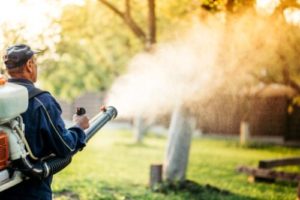 Numerous things can impact the health of a tree—these range from pesky insects to nutritional deficiencies to diseases. One simple component of tree healthcare any homeowner can take advantage of are chemical applications. When applied to trees, chemical applications can protect against insects and restore or maintain tree health. Distributing a chemical application can be done through injections, spray applications, or by spreading directly on the soil surrounding the base of a tree’s trunk. Contact Prestige Tree Experts at 240.281.3334 to learn more about Maryland-based tree services.
Numerous things can impact the health of a tree—these range from pesky insects to nutritional deficiencies to diseases. One simple component of tree healthcare any homeowner can take advantage of are chemical applications. When applied to trees, chemical applications can protect against insects and restore or maintain tree health. Distributing a chemical application can be done through injections, spray applications, or by spreading directly on the soil surrounding the base of a tree’s trunk. Contact Prestige Tree Experts at 240.281.3334 to learn more about Maryland-based tree services.
Common Chemical Applications for Tree Healthcare
Two different categories of chemical applications are used for tree disease treatments. They are micro-injections and sprays. Each is explored in more detail below.
Micro-Injections
Micro-injections involve inserting small, chemical-filled capsules directly into the trunk of a tree. The capsules deliver therapeutic chemicals that aid in healing a tree or curing it of disease. Application is usually made near the base of a tree, ideally in or around a trunk wound. The sap movement within the tree then distributes these chemicals up the trunk and through its branches. One benefit of micro-injections is that the tree fungus treatment, insecticide, or nutrients are delivered directly to the tree and do not contact the surrounding environment. It is also incredibly affordable as it does not require fancy or complex arborist equipment.
While the practice of micro-injections to boost tree health dates back centuries, it remains a misunderstood technique, with many people continuing to use high-pressure applications during injection. In fact, using high-pressure methods causes damage to the tree’s inner woody tissues. Micro-injections should always be done using low-pressure injection. The other way this practice can be misapplied is through macroinjection. Most trees cannot handle more than a tiny amount of fluid being injected. Micro-injections are usually less than one ounce.
Spray Applications
The other category of chemical applications are sprays. Most trees will never need a spray application to remain healthy. Some estimates categorize 90% of spray applications as unnecessary if not harmful. Moreover, cover sprays, a technique where all trees or shrubs present on a property are sprayed at once, are never recommended as that volume of spray can damage an ecosystem. Often the best way to ensure tree health is to make sure the habitat you put it in is well-suited for its presence. For instance, crowding pines and spruce trees can result in needlecast disease. And some trees do poorly in soils with high pH levels.
Yet spray applications do have quality use cases. These often mean specific application in narrow circumstances. Contacting a local tree expert is a great first step in deciding whether your property could benefit from a spray application on some of its trees. A great example is the case of leaf miners and leaf eaters. Both are insects that eat green leaves and needles. A comprehensive spray on the affected trees may be warranted when an infestation has built up.
Restoring Tree Healthcare
Resorting to chemical applications to boost the health of your trees may be necessary. But tree diseases can sometimes be avoided through careful planning and tree maintenance. Some tips to promote better tree health in your yard include:
- Test your soil prior to major planting projects
- Stick to native plants as much as possible
- Consider watering trees, especially ornamentals, during any dry spells within their first three years after planting
- Mulch around the base of trees with organic mulch to control temperature extremes and prevent mower damage
If you follow those tips and still find your trees needing extra help to stay healthy, a chemical application may be the answer. Call 240.281.3334 to find out how Prestige Tree Experts can support you in keeping your property’s trees in tip-top shape.
